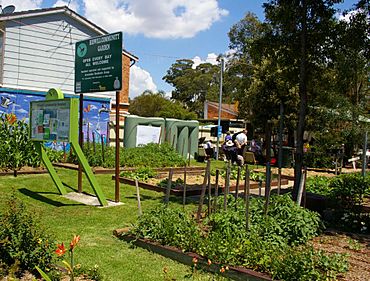Bidwill, New South Wales facts for kids
Quick facts for kids BidwillSydney, New South Wales |
|||||||||||||||
|---|---|---|---|---|---|---|---|---|---|---|---|---|---|---|---|

Bidwill Community Garden, Chestnut Crescent
|
|||||||||||||||
| Population | 4,280 (2016 census) | ||||||||||||||
| Postcode(s) | 2770 | ||||||||||||||
| Elevation | 52 m (171 ft) | ||||||||||||||
| Location | 48 km (30 mi) west of Sydney CBD | ||||||||||||||
| LGA(s) | City of Blacktown | ||||||||||||||
| State electorate(s) | Mount Druitt | ||||||||||||||
| Federal Division(s) | Chifley | ||||||||||||||
|
|||||||||||||||
Bidwill is a suburb located in Sydney, New South Wales, Australia. It is about 48 kilometres west of the main Sydney central business district. Bidwill is part of the City of Blacktown area and the larger Greater Western Sydney region.
Contents
Discovering Bidwill's Past
Bidwill gets its name from John Carne Bidwill. He was a botanist who worked at the Botanic Gardens in 1847. Before European settlement, the Darug tribe lived in the Bidwill area.
In the 1960s and 1970s, many public houses were built in Bidwill. Over time, these homes are slowly becoming privately owned. Newer, modern houses are replacing the older ones.
Shopping and Services
Bidwill is mostly a place where people live. It does not have many big shops. However, it is close to Mount Druitt and St Marys. These nearby suburbs have larger shopping centres. They also have banks and train stations.
You can find some shops like supermarkets and petrol stations in nearby Emerton and Plumpton. In the past, Bidwill had a small supermarket complex. It closed because of competition from bigger stores nearby. There are still efforts to reopen this shopping area.
Getting Around Bidwill
Most people in Bidwill use cars to get to work. In 2016, about 74.5% drove or were passengers in a car. About 12.4% used public transport. Busways provides bus services in the area.
Bidwill is right next to the Westlink M7 motorway. This makes it easy to reach the Great Western Highway and the M4 Motorway. These roads connect Bidwill to other parts of Sydney. Buses also link Bidwill to train stations at Mount Druitt and St Marys.
There are also cycleways for bikes in Bidwill. You can ride from Poppondetta Park to Mount Druitt. The M7 cycleway connects to other cycleways on the M4 and M2 motorways.
Learning in Bidwill
Bidwill has a shared campus for education. It includes Bidwill Primary School and the Bidwill campus of Chifley College. There is also a pre-school on the campus. This means students can get care and education from age 3 up to Year 12 (around 17-18 years old).
After Year 10 at Bidwill Campus, students can continue their studies. They can go to the Chifley College Senior Campus in Mount Druitt. Or, they can finish their final years at Bidwill Campus.
In 2016, about 38.4% of people in Bidwill were attending school. This included 27.7% in primary school. Also, 20.6% were in secondary school. About 9.4% were in college or technical training.
Who Lives in Bidwill?
The 2016 census counted 4,280 people living in Bidwill.
- About 13.1% of the people were Aboriginal and Torres Strait Islander.
- Most people (65.3%) were born in Australia.
- Other common birthplaces included New Zealand (3.6%) and Samoa (2.8%).
- English was the only language spoken at home by 72.3% of people.
- About 25% of homes spoke two or more languages.
- Other languages spoken include:
- Samoan (6.2%)
- Arabic (2.4%)
- Tongan (1.4%)
- Cook Islands Māori (1.3%)
- Spanish (1.3%)
- For religion, the most common answers were No Religion (24.6%), Catholic (21.9%), and Anglican (15.6%).
Homes in Bidwill
Most homes in Bidwill were built in the 1960s and 1970s. Many are freestanding fibro houses. There are also many terrace-style homes. These government-built homes are slowly being sold to private owners. New, modern homes are replacing them.
Most local housing is owned by Department of Housing or the Aboriginal Housing Office. In Bidwill, 64.6% of occupied homes were separate houses. About 33.6% were semi-detached homes.

